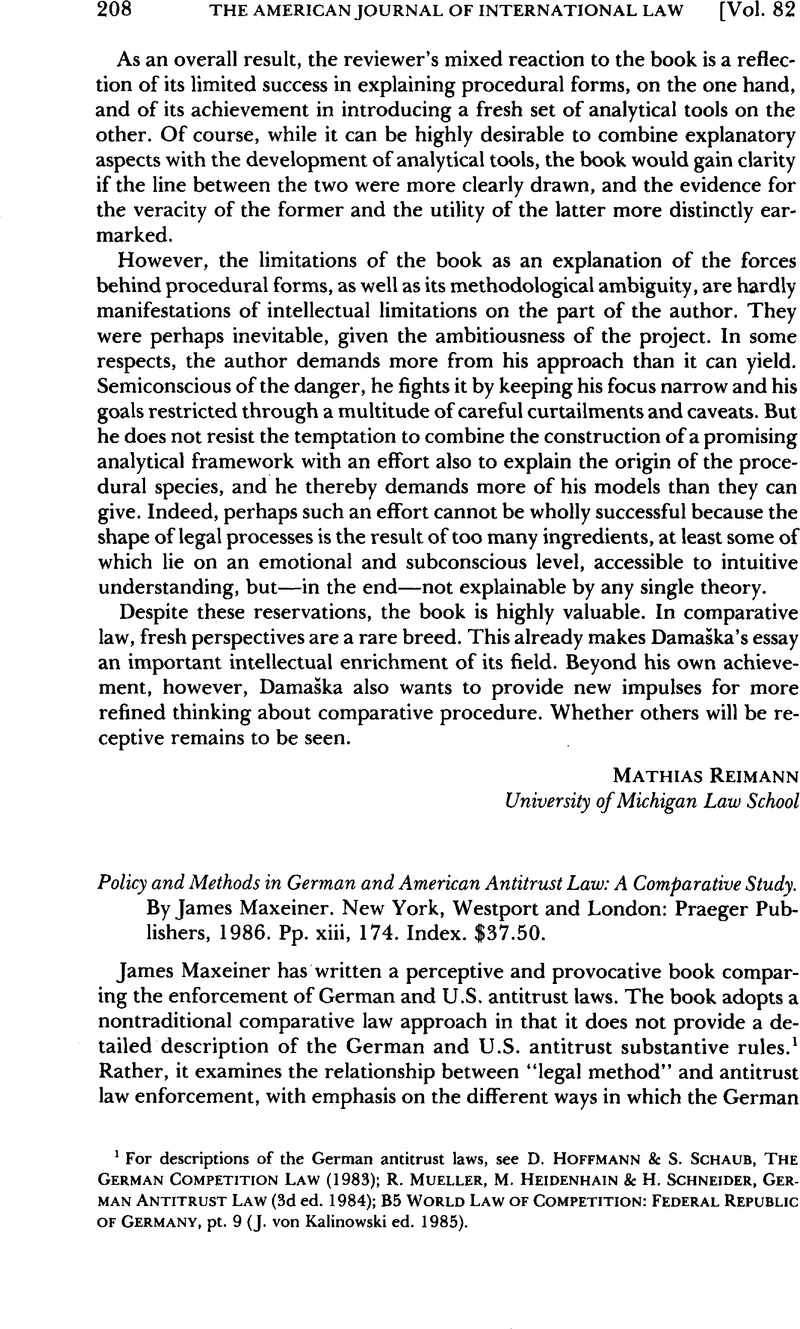No CrossRef data available.
Published online by Cambridge University Press: 27 February 2017

1 For descriptions of the German antitrust laws, see Hoffmann, D. & Schaub, S. The German Competition Law (1983)Google Scholar; Mueller, R., Heidenhain, M. & Schneider, H. German Antitrust Law (3d ed. 1984)Google Scholar; B5 World Law of Competition: Federal Republic of Germany, pt. 9 (J. von Kalinowski ed. 1985).
2 The other is the competition law of the European Communities. See 2 Hawk, B. United States, Common Market and International Antitrust, chs. 7–13 (2d ed. 1985)Google Scholar.
3 Of course, disagreement about substantive rules can result not only from differences in policy analysis but also from concerns about the predictability and costs associated with the rules. See, e.g., Easterbrook, The Limits of Antitrust, 63 Tex. L. Rev. 1 (1984)Google Scholar.
4 See FTC v. Procter & Gamble Co. (Clorox), 386 U.S. 568 (1967).
5 See R. Bork, The Antitrust Paradox (1978); and R. Posner, Antitrust Law (1976).
6 The Federal Trade Commission also embraced the same approach at about the same period with the appointment of James Miller as Chairman.
7 Continental T.V. v. GTE Sylvania, 433 U.S. 36 (1977) (overruling United States v. Arnold, Schwinn & Co., 388 U.S. 365 (1967)).
8 See, e.g., Westman Comm’n Co. v. Hobart Int’l, 796 F.2d 1216 (10th Cir. 1986); Valley Liquors v. Renfield Importers, 678 F.2d 742 (7th Cir. 1982).
9 See e.g., Rothery Storage & Van Co. v. Atlas Van Lines, 792 F.2d 210 (D.C. Cir. 1986).
10 See, e.g., United States v. Siemens Corp., 621 F.2d 499 (2d Cir. 1980) (conglomerate merger); Stroh Brewing Co. v. Malmgren, 1982–1 Trade Cas. (CCH) ¶64,670 (W.D. Wis. 1982) (horizontal merger); United States v. Black & Decker Mfg. Co., 430 F.Supp. 729 (D. Mass. 1976) (conglomerate merger).
11 For example, see Fox, The Modernization of Antitrust, 66 Cornell L. Rev. 1140 (1981)Google Scholar.
12 See, e.g., Williamson, Antitrust Enforcement: Where It’s Been, Where It’s Going, 27 St. Louis U.L.J. 289 (1983)Google Scholar. For a discussion of the possible effect of U.S. antitrust law developments on the law of the European Communities, see Hawk, The American (Antitrust) Revolution: Lessons for the EEC? Google Scholar Eur. Comp. L. Rev. (forthcoming).
13 For example, even if the entire body of economic theory ultimately rejected competition and free markets, courts would remain constrained to follow the fundamental legislative goal of competition expressed in the antitrust laws.
14 15 U.S.C. §18 (1982).
15 See, Report of the National Commission for the Review of Antitrust Laws and Procedures (1979).
16 74 Geo. L.J. 999(1986).
17 As to court decisions, see Ball Memorial Hosp. v. Mutual Hosp. Ins., 784 F.2d 1325 (7th Cir. 1986); United States v. Realty Multi-List, 629 F.2d 1351 (5th Cir. 1980). As to commentators, see 7 P. Areeda, Antitrust Law 361 (1986); and Easterbrook, supra note 3. The Solicitor General advocated adoption of a “structured rule of reason” in National Collegiate Athletic Ass’n v. Board of Regents of the University of Oklahoma, 468 U.S. 85 (1984).
18 See Antitrust Remedies Improvements Act of 1987, reprinted in Antitrust & Trade Reg. Rep. (BNA), No. 52, at 350 (Feb. 19)(1987).
19 For example, Congress effectively blocked the Justice Department from attacking the per se ban on resale price maintenance before the Supreme Court in the Monsanto litigation.
20 For example, the National Association of Attorneys General issued its own set of Vertical Restraints Guidelines in reaction to those issued by the Justice Department. See NAAG, Vertical Restraints Guidelines (1985), reprinted in Antitrust & Trade Reg. Rep. (BNA), No. 49, at 996 (Dec. 5, 1986).